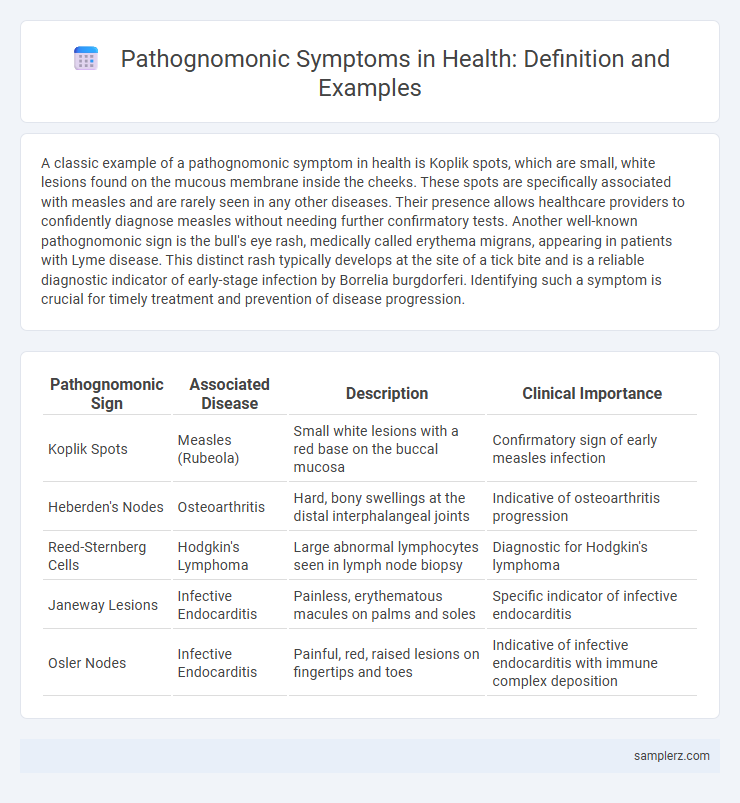A classic example of a pathognomonic symptom in health is Koplik spots, which are small, white lesions found on the mucous membrane inside the cheeks. These spots are specifically associated with measles and are rarely seen in any other diseases. Their presence allows healthcare providers to confidently diagnose measles without needing further confirmatory tests. Another well-known pathognomonic sign is the bull's eye rash, medically called erythema migrans, appearing in patients with Lyme disease. This distinct rash typically develops at the site of a tick bite and is a reliable diagnostic indicator of early-stage infection by Borrelia burgdorferi. Identifying such a symptom is crucial for timely treatment and prevention of disease progression.
Table of Comparison
| Pathognomonic Sign | Associated Disease | Description | Clinical Importance |
|---|---|---|---|
| Koplik Spots | Measles (Rubeola) | Small white lesions with a red base on the buccal mucosa | Confirmatory sign of early measles infection |
| Heberden's Nodes | Osteoarthritis | Hard, bony swellings at the distal interphalangeal joints | Indicative of osteoarthritis progression |
| Reed-Sternberg Cells | Hodgkin's Lymphoma | Large abnormal lymphocytes seen in lymph node biopsy | Diagnostic for Hodgkin's lymphoma |
| Janeway Lesions | Infective Endocarditis | Painless, erythematous macules on palms and soles | Specific indicator of infective endocarditis |
| Osler Nodes | Infective Endocarditis | Painful, red, raised lesions on fingertips and toes | Indicative of infective endocarditis with immune complex deposition |
Defining Pathognomonic Symptoms in Health
Pathognomonic symptoms are clinical signs or symptoms that definitively indicate the presence of a specific disease, such as Koplik spots for measles or the presence of a bull's-eye rash in Lyme disease. These symptoms provide conclusive evidence for diagnosis, eliminating the need for further testing to confirm the disease. Recognizing pathognomonic symptoms is critical in health care for prompt and accurate treatment interventions.
Why Pathognomonic Signs Matter in Diagnosis
Pathognomonic signs, such as Koplik spots in measles or the Bull's eye rash in Lyme disease, provide definitive evidence of a specific illness, enabling accurate and timely diagnosis. These unique clinical indicators reduce diagnostic uncertainty and guide targeted treatment, improving patient outcomes. Emphasizing pathognomonic signs enhances diagnostic precision by differentiating diseases with overlapping symptoms.
Classic Pathognomonic Symptoms in Infectious Diseases
The Koplik spots are classic pathognomonic symptoms of measles, characterized by small white lesions on the buccal mucosa appearing before the rash onset, confirming diagnosis. Another pathognomonic sign is the bull's eye rash (erythema migrans) seen in early Lyme disease, which is distinctive for Borrelia burgdorferi infection. The presence of a painless chancre is pathognomonic for primary syphilis, typically appearing at the site of Treponema pallidum entry.
Neurological Disorders: Recognizing Pathognomonic Indicators
Pathognomonic signs provide definitive diagnosis clues in neurological disorders, such as the presence of the Babinski sign indicating upper motor neuron lesion. The cherry-red spot observed in Tay-Sachs disease exemplifies a pathognomonic retinal finding specific to this neurodegenerative disorder. Recognition of these pathognomonic indicators streamlines clinical diagnosis and guides targeted treatment approaches.
Dermatological Conditions with Pathognomonic Features
The presence of the "herald patch" is a pathognomonic feature of pityriasis rosea, a common dermatological condition characterized by a solitary, oval, pink lesion often followed by a distinctive Christmas-tree pattern rash on the trunk. Another hallmark sign is the "silver scales" typical of psoriasis, indicating chronic plaque psoriasis with sharply demarcated erythematous plaques covered by silvery-white scales. Lichen planus exhibits Wickham's striae, fine white lines or dots on violaceous papules, serving as a definite diagnostic marker in mucocutaneous presentations.
Pathognomonic Symptoms in Autoimmune Diseases
Pathognomonic symptoms, such as the malar rash in systemic lupus erythematosus (SLE), serve as definitive clinical markers for autoimmune diseases. These distinct manifestations enable precise diagnosis by uniquely correlating with specific immune-mediated disorders, avoiding diagnostic ambiguity. Recognizing pathognomonic signs streamlines targeted therapeutic interventions, improving patient outcomes in complex autoimmune conditions.
Cardiovascular Diseases: Unique Diagnostic Markers
A pathognomonic symptom in cardiovascular diseases is the presence of a "murmur of aortic stenosis," which distinctly indicates narrowing of the aortic valve. The detection of a loud, crescendo-decrescendo systolic murmur at the right upper sternal border, radiating to the carotid arteries, is a unique diagnostic marker confirming aortic valve pathology. These specific auscultatory findings are crucial for early detection and targeted management of aortic stenosis in clinical cardiology.
Pediatric Pathognomonic Symptoms Explained
Koplik spots are a pathognomonic symptom in pediatric measles, characterized by small white lesions on the buccal mucosa appearing before the rash. The presence of a "bullous" rash in Staphylococcal scalded skin syndrome uniquely identifies the condition in infants and young children. Pediatric acute rheumatic fever features Sydenham chorea, a distinct neurological symptom that confirms diagnosis without further lab tests.
Pathognomonic Signs in Rare Medical Conditions
Pathognomonic signs are distinctive clinical features that unequivocally indicate a specific rare medical condition, such as Koplik spots in measles or the "butterfly rash" characteristic of systemic lupus erythematosus. These signs provide crucial diagnostic clues, enabling healthcare professionals to differentiate rare diseases from more common ailments effectively. Recognizing pathognomonic symptoms accelerates accurate diagnosis and guides appropriate treatment protocols in complex clinical scenarios.
Challenges in Identifying True Pathognomonic Symptoms
Identifying true pathognomonic symptoms poses significant challenges due to symptom overlap across various diseases and individual patient variability. For example, Koplik spots are pathognomonic for measles, yet their transient appearance can lead to misinterpretation or missed diagnosis. Accurate recognition requires thorough clinical knowledge and careful differential diagnosis to avoid diagnostic errors and ensure prompt, targeted treatment.

example of pathognomonic in symptom Infographic
 samplerz.com
samplerz.com